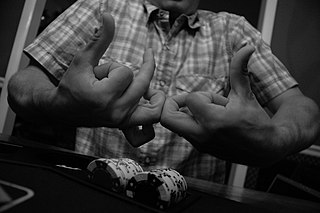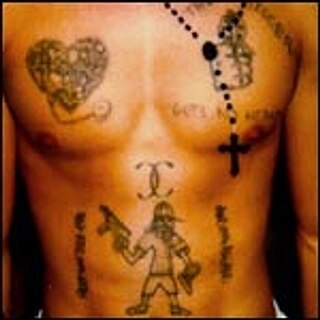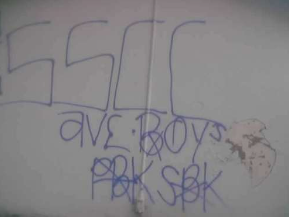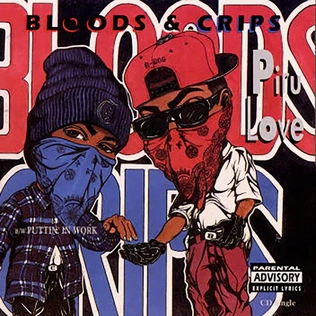
Marion Hugh "Suge" Knight Jr. is an American music executive and kingpin who is the co-founder and former CEO of Death Row Records. Knight was a central figure in gangsta rap's commercial success in the 1990s. This feat is attributed to the record label's first two album releases: Dr. Dre's The Chronic in 1992 and Snoop Dogg's Doggystyle in 1993. Knight is serving a 28-year sentence in prison for a fatal hit-and-run in 2015.

The Bloods are a primarily African-American street gangs which was founded in Los Angeles, California. The gang is widely known for its rivalry with the Crips. It is identified by the red color worn by its members and by particular gang symbols, including distinctive hand signs.

Raymond Lee Washington was an American gangster, known as the founder of the Crips gang in Los Angeles. Washington formed the Crips as a minor street gang in the late 1960s in South Los Angeles, becoming a prominent local crime boss. In 1971, Washington formed an alliance with Stanley "Tookie" Williams, establishing the Crips as the first major African-American street gang in Los Angeles, and served as one of the co-leaders. In 1974, Washington was convicted of robbery and received a five-year prison sentence, during which his leadership and influence in the Crips declined.

The Crips are an alliance of street gangs that is based in the coastal regions of Southern California. Founded in Los Angeles, California, in 1969, mainly by Raymond Washington and Stanley Williams, the Crips began as an alliance between two autonomous gangs, and developed into a loosely connected network of individual "sets", often engaged in open warfare with one another. Its members have traditionally worn blue clothing since around 1973.
The Jungles faction of the Black P. Stones street gang is a division ("set") of the Bloods gang alliance in Los Angeles. Originating in Los Angeles' Baldwin Village neighborhood in the 1960s, the Black P. Stones became one of the largest gangs in the city. The gang has been linked to various crimes, including murders, assaults, robberies, narcotics violations and firearms violations, and has been the subject of numerous FBI and LAPD investigations.

The Cedar Block Piru is a "set" of the Piru gang alliance, which itself is part of the larger Bloods gang alliance. The gang gained notability for its connection to rapper The Game, who has referenced the gang in several of his songs.
Bloods & Crips was an American gangsta rap group from Los Angeles County mostly known for their record selling song "Piru Love".

The Bounty Hunter Watts Bloods, also known as the Bounty Hunter Bloods, is a predominantly African American street gang situated in the Nickerson Gardens public housing projects in Watts, Los Angeles.

On September 7, 1996, at 11:15 p.m. (PDT), Tupac Shakur, a 25-year old American rapper, was fatally shot in a drive-by shooting in Las Vegas, Nevada. The shooting occurred when the car carrying Shakur was stopped at a red light at East Flamingo Road and Koval Lane.
RedruM 781 was an American rapper from Inglewood, California. RedruM 781, Tweedy Bird Loc and producer Ronnie Phillips organized the hip hop project Bloods & Crips, a collaboration between Bloods and Crips members. He was a Piru gang member himself. redruM 781 is also known for his key role on "Bangin' on Wax", he and his fellow female MC Bloody Mary were the two key players for getting this particular Bangin' on Wax project off the ground. He was the cousin of the rapper Kurupt, with whom they had a long-time beef.

Chicago is considered the most gang-occupied city in the United States, with 150,000 gang-affiliated denizens, representing more than 100 gangs. Gang warfare and retaliation is common in Chicago. Gangs were responsible for 61% of the homicides in Chicago in 2011.

The East Side Mob Piru are a "set" of the Piru gang alliance, which is itself part of the larger Bloods alliance. Suge Knight, the co-founder and former CEO of Death Row Records, is an affiliate.

The South Side Compton Crips are a "set" of the Crips gang alliance, based in Compton, California. This gang is known for the murder of Tupac Shakur.

The Fruit Town Piru are a "set" of the Piru gang alliance, which itself is part of the larger Bloods alliance. This Piru set is known for its rivalry with the Mob Piru Bloods during the early 2000s.

The Crenshaw Mafia are a "set" of the Bloods gang alliance. The gang are depicted in several movies including Boyz n the Hood and Straight Outta Compton.

"Piru Love" is a song from the 1993 album Bangin' on Wax by the gangsta rap group Blood & Crips. It was subsequently released as a single, along with several alternate versions of the song. It is the group's most popular single.

The Elm Street Piru are a "set" of the Piru gang alliance, which itself is part of the larger Bloods alliance. The Elm Street Piru started in Compton, California, but has since spread to other parts of the United States.















